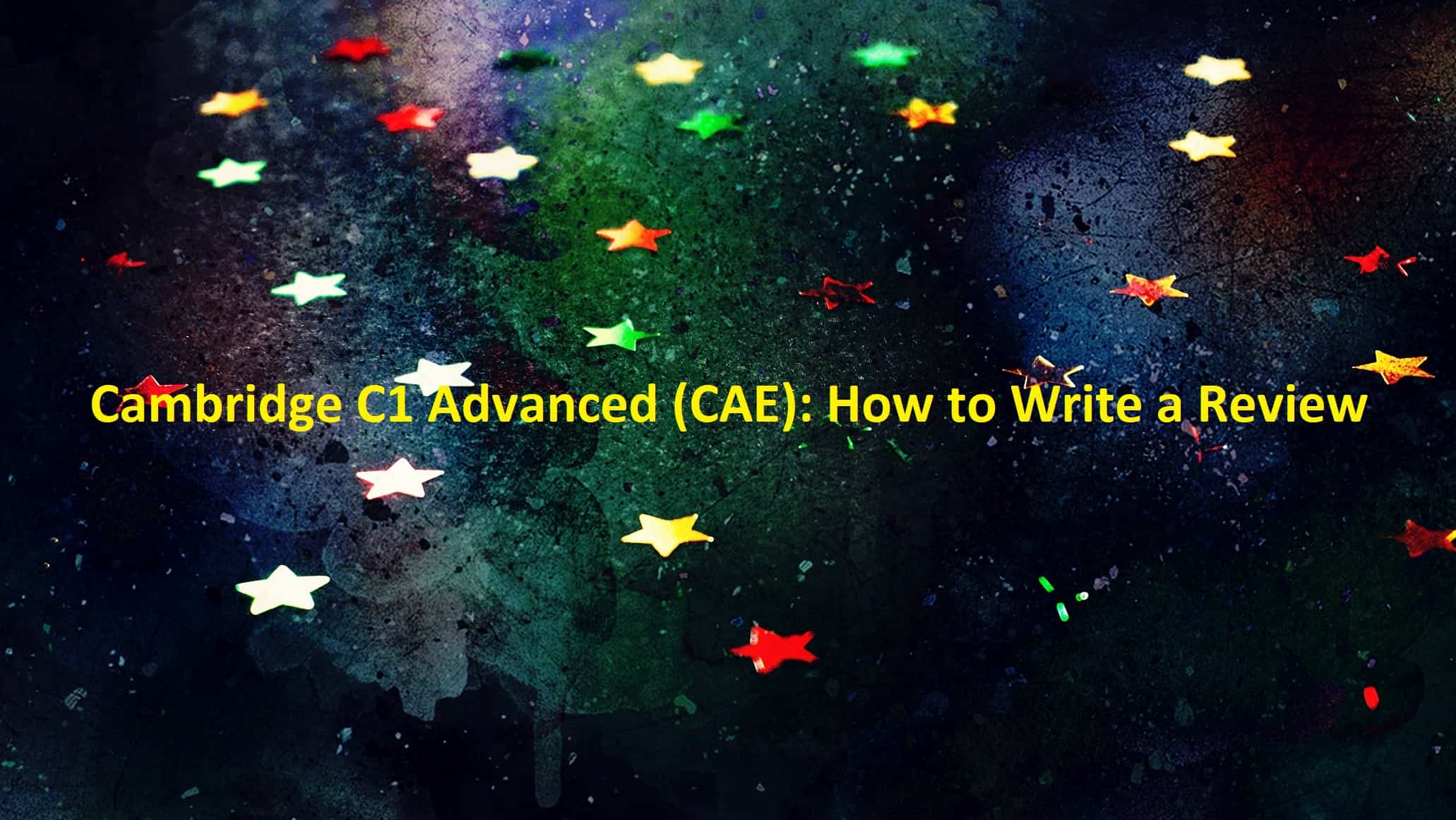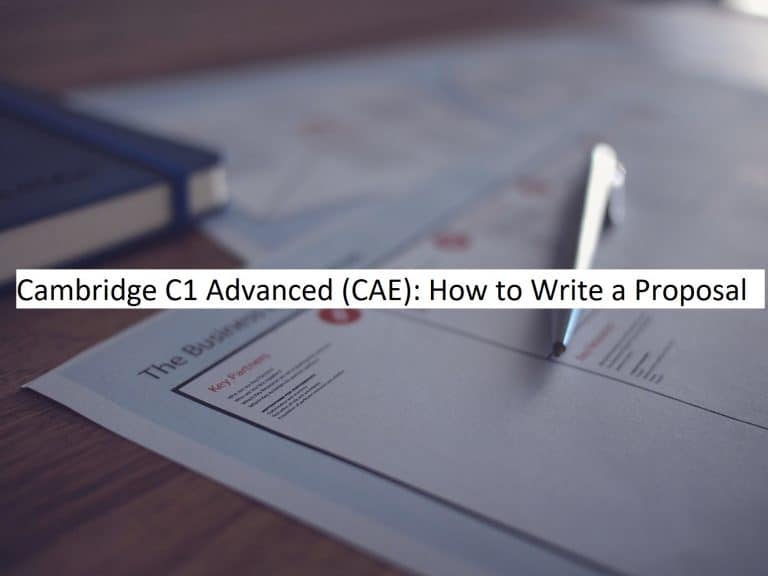Get Your Free C1 Advanced Writing Cheat Sheet Now!
Just leave your name and email address below.
Thank you!
Please check your email inbox and spam folder for your free PDF.
Introduction
A review may be about a book, magazine, film, play or concert; it may also be about a product or a service. A review in the C1 Advanced Writing paper does not merely ask for a general description of the thing reviewed, but requires an evaluation of its suitability for a particular purpose or audience. The target reader is specified in the task, and candidates should be encouraged to use this information when choosing appropriate ideas and language to include in their response.
from: Cambridge English First Handbook for Teachers
In the C1 Advanced Writing exam there are two parts. Part 1 always requires you to write an essay while in Part 2 you can choose from different text types. Apart from reviews, you can also decide to pick a proposal, a report or an email/letter.
Reviews are fun!
Reviews are fun because reading reviews is fun. Who doesn’t enjoy a few opinions from other people before making the decision on which restaurant to go to, which film to watch or which book to buy? Also, in our day and age, we are constantly looking at social proof for a wide range of topics so reviews are much more natural to us than they were only a few years ago when the internet wasn’t everywhere so you might even have written about a few of your own experiences online.
Of course, when writing a review for C1 Advanced you have to follow a specific structure and fulfill certain requirements, but the good thing for you is that they are always the same so you can study and practise them and become better every single day until you get to the official exam and it won’t be a problem for you anymore.
We are going to look at different aspects of review writing, from looking at a typical task and its structure, useful language and mistakes to avoid. If you are interested, keep reading.
>>> Find out how your C1 Advanced writing is marked. <<<
What a typical review task looks like
Speaking from my experience as a teacher and preparing numerous students for the exam, I can say that most review tasks look pretty much the same. The structure is very very similar and once you know what to look for, you can use it to your advantage by saving a lot of time and going into the test ready and calm.
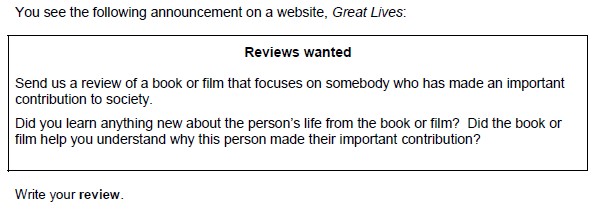
When you see a writing task for C1 Advanced (not only reviews, but really all of them), you should always ask your self a few very specific questions which can help you to better understand what you have to do and set you up for a successful writing exam.
- What is the situation? (topic)
- What exactly do I have to include in my review? (main points)
- Who is going to read the review?
To find the answers to these three questions read the task very carefully and underline the key information.
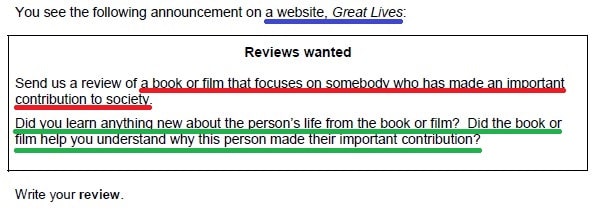
I underlined the information in different colours as each colour refers to one of the questions from above. First of all, the topic is underlined with red. Secondly, the main points or questions you have to answer in your review are green and, finally, you are writing for a website called Great Lives (blue).
This structure is usually the same in every task so make sure that you look for the same type of information whenever you sit down to practise reviews.
You might ask yourself why it is so important to know who you are writing for, but this tells you exactly if you should use formal, neutral or informal language. Imagine you had to write to your boss or the director of your school. You would choose a more formal style than if you were writing to your friends. In our example, we should choose something that is more of a neutral style. After all, we don’t the people on the website, but we want to keep it light and as interesting as possible.
When writing in a neutral style you can use contractions like ‘I’m’ or ‘don’t’ and you can use phrasal verbs as well as interesting adjectives and adverbs to make your review more lively. However, I wouldn’t recommend using slang words or too many colloquial expressions nor anything that is too formal as you would in an essay or formal letter.
How to organise your review
Now that we know what the task’s topic is, what exactly we need to include and the tone we should write in, it is time to look at the structure of a review. Luckily, this can be repeated from review to review and you simply have to change the content depending on the topic and main points.

Remember, there are two main questions for you to answer here (Did you learn anything new about the person’s life? Did the book or film help you understand why this person made their important contribution?) It makes a lot of sense to give each of those questions their own paragraph as they talk about different aspects of your review.
Additionally, you should add an introduction (with a title) in which you create some anticipation and engage the reader as well as a conclusion where you summarise your main points and make a recommendation (because that’s why we read reviews). In total, that comes to four paragraphs which could look like this:
- Title/Introduction
- What new things did you learn about the person’s life?
- Do you now better understand why the person made their important contribution?
- Conclusion/Recommendation
Obviously, your main topic paragraphs should be longer than the intro and conclusion, and keep in mind that there is a word limit of 220-260 words.
Always plan your review
I say this in every article I write here on teacherphill.com and I’m going to say it again in this post because it is such an important piece of advice. Unfortunately, many candidates simply ignore or forget about it and find themselves in the official C1 Advanced exam nervous and unprepared so I want you to include this in your practice.
Whenever you sit down to write for your exam preparation, make a plan before you start your review, report, proposal, email/letter or essay. It only takes 3-5 minutes and it can save you so much time down the road when you need to make corrections.
A plan can be very short and only include a few keywords that you add under each heading so you know what you want to write about and don’t have to rethink everything halfway through the writing task.
- Mandela: Long Walk to Freedom – Ask a question to engage reader. Brief life background.
- New things I learned – his work as a lawyer, marriage problems, his reliance on Winnie
- Why did he do all of it – oppression in South Africa was terrible
- Conclusion: The film gives great insight into Mandela’s life. I definitely recommend it.
There you have it. It took me just a couple of minutes to jot down my ideas and now that they are recorded on paper we are ready to write our review.
The different parts of a review
After looking at how to analyse a task as well as organise and plan your review, it is time to get into actually writing it. We are still going to work on our example task and, of course, you might have to adjust your language and content for different topics, but you should get a good idea of what is expected from you when writing a review for C1 Advanced.
Introduction
The introduction of a review aims to engage the reader from the beginning. You want to create interest and anticipation of what you have to say about the book, film, restaurant or whatever else you might be reviewing.
It is always a good idea to start with a question because you can involve the reader’s own mind and, therefore, generate the engagement you want. Also, don’t give any spoilers, but hint at what’s going to come in the rest of the text.
Let’s look at a possible introduction.
Mandela: Long Walk to Freedom – a review
Have you ever been so passionate about something that you would sacrifice your very best years for it? Would you even put it ahead of your family and friends? In the film Mandela: Lond Walk to Freedom we get not only a glimpse of Nelson Mandela’s life, but rather dive deep into who he was and how he changed a whole country.
I gave my review a title, which doesn’t have to be fancy, and in the introduction I didn’t do anything crazy either. It starts with a couple of questions to generate interest and I don’t give away too much of the storyline. Obviously, a lot of people know something about Nelson Mandela’s life, but that’s not the point. Give the reader just a tiny little taste so they want more and keep reading.
Body
The body of your review for C1 Advanced includes all the main topic points that we elicited earlier from the example task.
- What new things did you learn about the person’s life?
- Do you now better understand why the person made their important contribution?
Each point gets its own paragraph to make sure that the text is clearly organised.
You also want to make sure that you keep the reader’s attention which you have carefully caught in the introduction. Treat it like something very valuable that you don’t want to lose again until the end of your review.
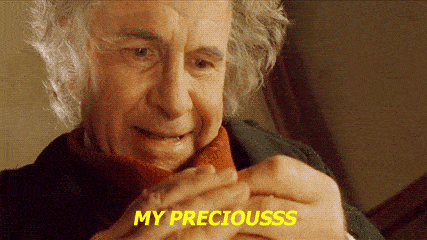
While the whole film captivated me throughout, there was one aspect that truly stood out to me. Nelson Mandela and his second wife Winnie had a one-of-a-kind relationship driving each other to continue and grow the anti-apartheid movement in South Africa even after Mr Mandela was captured and imprisoned. It is a testament to their dedication and partnership and something that a lot of us can learn from.
Despite having a strong and driven partner in his wife, I still used to be astonished by the fact that someone would simply sacrifice themselves and give up a big part of their life to help others, but this biopic made me reconsider. Witnessing a segregated society and all the racial abuse the black community had to endure during apartheid, there was no other option for Nelson Mandela than to stand up and fight for equality.
I’ve highlighted some of the more important language features for you. At the beginning of each paragraph, I play with contrasting statements (while, despite) as this keeps the reader guessing. I also tried to use some vocabulary that is specific to Mandela’s life (anti-apartheid movement, sacrifice themselves, segregated society, racial abuse…had to endure, stand up and fight for equality) and some words and expressions to make the review more interesting for the reader (one-of-a-kind, captured and imprisoned, it is a testament to…, astonished).
All of these little things together make for an engaging review that the reader wants to read fully and thoroughly.
Conclusion/Recommendation
To finish your review you need a conclusion in which you summarise what you’ve written up to this point and make a recommendation to the reader. After all, that’s why we read reviews in the first place – we want someone to tell us about a product or an experience and see if they would recommend it or not.
There is some specific language that you should incorporate when you make a recommendation because you want to persuade the reader and make the examiner happy:
- I recommend/suggest [title/name] to + person
- I recommend/suggest + -ing
- I recommend/suggest that …
- You should + base verb
- You might want to + base verb
Nothing crazy, but you want to cover all the bases.
All in all, Mandela: Long Walk to Freedom gives some incredible insight into the life of one of the world’s most famous and influential personalities of the 20th century. It would be a shame not to watch it so I highly recommend that you check your favourite streaming service or buy the film as soon as you can and I promise you won’t regret it.
You see that it is very much straightforward. The first sentence recaps what I like about the film and the second one makes a recommendation and tries to persuade the reader (“I promise you won’t regret it.”).
How your review is marked
The marking scheme in C1 Advanced is pretty complex and there are a lot of things for the examiner to consider when checking your review. For this reason, I decided to write an article about how the writing paper in CAE is marked and you check it out by following the link below.
>>> Find out how your writing in C1 Advanced is marked. <<<
Now it is up to you
Take the advice in this article and start practising reviews. With more experience it will become easier and easier for you and when the official exam comes around, you will be ready.
Lots of love,
Teacher Phill 🙂

